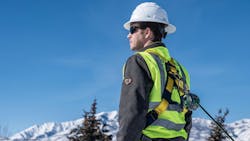When it comes to personal protective equipment (PPE), most pieces of equipment are designed to protect a worker right out of the packaging. When a worker faces potential hand injuries, simply providing them with appropriate safety gloves immediately reduces the risk factor for an employee without changing how they perform their task. Similarly, if a worker faces eye injuries from a task like grinding or cutting, simply donning safety glasses can protect the worker’s eyes from debris or other hazardous material. Gloves and glasses are not necessarily technical pieces of safety equipment; therefore, most workers will naturally don them correctly or with minimal training. But when it comes to fall protection equipment, it’s common for workers to improperly don the equipment, which can potentially allow them to work while still being exposed to the risk of injury or worse.
The importance of proper harness fit
The Occupational Safety & Health Administration (OSHA) mandates that manufacturer’s instructions be followed for safety equipment. If workers do not fit their PPE according to its design, they prevent the equipment from doing its job. Besides the risk of violating OSHA requirements that can lead to citations and potential injury, this practice leads to the worker being less protected by their equipment.
Fall protection harnesses are designed to fit tight and ensure the body remains as stationary as possible during a fall incident. This allows the harness to absorb as much force of the fall as possible. A loose-fitting harness allows the body to move around too much, and the user will feel more force during a fall, furthering the risk of injury. One must remember that during a fall, the victim is simultaneously being pulled down by the forces of gravity and up by the equipment trying to successfully arrest their fall. A properly fitting harness is the lynchpin between ultimate safety being achieved and additional accidental injury occurring. A properly fitting harness helps prevent the latter.
Pre-use inspections are required on all pieces of fall protection equipment, and harness fit should be part of that inspection. Ensuring the harness is free of defects is as important as ensuring proper fit.
Determining the correct harness size
One of the most common misuse violations seen in the field is when employees incorrectly don their fall protection harnesses. Manufacturers offer multiple sizes for harnesses, and proper fit is the first step in ensuring a personal fall arrest system (PFAS) will work as expected in the event of a fall.
The industry standard is a five-point adjustable harness that will range between the printed sizes on the label. For example, a harness can be sold as small/medium, meaning it will fit a “small” worker to a “medium” worker. This is to accommodate people with longer torsos, shorter legs, bulkier clothing in colder climates, etc. When adjusting the harness,s there are several techniques to ensure an employee has the correct size harness for their body type. It's important to note that the American National Standard Institute (ANSI) only allows workers ranging from 130 pounds to 420 pounds to use fall protection equipment, regardless if the harness fits properly.
Tips for adjusting leg straps
When donning a harness, the user should unfasten the torso and leg connections — and loosen the shoulder and leg straps to their fullest extension before placing them on their shoulders, similar to putting on a backpack. This allows for easy adjustments to fine-tune a fit to the user’s height and body shape.
The user should first attempt to connect the leg straps. When connecting the leg straps, the user should situate the strap as horizontally as possible in a comfortable position on the upper thigh. The leg straps should never come in contact with the groin area. This part of the harness is of great significance in successfully arresting a fall without further injury to the worker. If the leg straps are too loose, they will “tighten” instantly during a fall, and the user will feel abrupt forces on their lower pelvic area.
Correctly tightened leg straps will still feel like they tighten during a fall, but they will not move up the leg — they will stay in the desired area. Connect the leg buckles and tighten them so that a flat palm can fit between the leg and the strap, but not a fisted hand. When properly tightened, the leg straps should not move up and down the leg while walking but remain stationary in their location.
Tips for adjusting torso and shoulder straps
At this point, the user should have two properly adjusted leg straps and now must adjust their torso and shoulder straps. Align the torso strap so that it sits horizontally across the chest. Similar to the leg straps, incorrect placement of the torso strap could cause further injury.
If the torso strap is too high on the user’s chest during a fall, it has the potential to slide up and put pressure on the user’s neck. If the torso strap is too low, the dorsal D-ring on the back of the harness will not sit in its proper position. To verify the proper placement of the torso strap, the user should place their arms flat against the side of their body. If the strap is in the right place, it should sit directly between the two crevices made from the user’s armpits.
The user might need to tighten the two shoulder straps at this time to achieve proper alignment of the torso strap. The shoulder straps should be tightened to the level that they put slight pressure on the user’s shoulders, but not so much that they feel uncomfortably tight over the shoulders. A properly fit harness should be felt all over the user’s body. Some people describe their harness as feeling like an exoskeleton that is conformed to their body.
Ideal dorsal D-ring location
Once a user believes their harness is properly fit, they should have another user or the site’s “competent person” approve the fit. Straps should not be twisted nor inverted, and all buckles should remain fastened until work is finished. If the harness must be adjusted while working, the user should only do so in an area where fall protection is no longer required.
Often, a properly fit harness naturally places a user’s dorsal D-ring at the ideal location on their upper back. The dorsal D-ring should sit centered between the shoulder blades on a user’s upper back. Too low of a D-ring does not allow for proper body positioning during fall arrest, and too high of a D-ring risks the user being struck in the head by their connection device’s snap hook or carabiner. The dorsal D-ring sits where many users can reach behind their backs, but that is not a fit requirement.
Training
OSHA requires employers to conduct annual training for employees who use fall protection equipment. However, if safety managers are noticing compliance issues or employees misusing equipment, more frequent training may be necessary. There is no way to determine exactly how much training an employee requires to ensure proper use of fall protection equipment, so safety managers must remain vigilant and ensure their employees are complying with industry best practices.
In conclusion
The complexity of maintaining a comprehensive fall protection program can’t be understated. Many factors can contribute to or inhibit a safety program’s success. Buy-in from company leadership, users complying with policies to the best of their abilities, and effective communication that leads to continuous improvement are some of the cornerstones of a successful safety program, but they are not enough to make the program work on its own. Everyone in the organization must do their part on a daily basis to contribute to the program’s effectiveness.
About the Author

Philip Jacklin
Philip Jacklin is the Continuing Education Program Manager for Diversified Fall Protection. He is an AIA continuing ed provider, QSSP certified, OSHA-30 trained, and has been a partner to the fall protection industry since 2018. Philip has a background in worker advocacy, team leadership, and fostering camaraderie among peers. He enjoys playing music, writing, and spending time in the sunshine with his family in Virginia Beach, Va.
